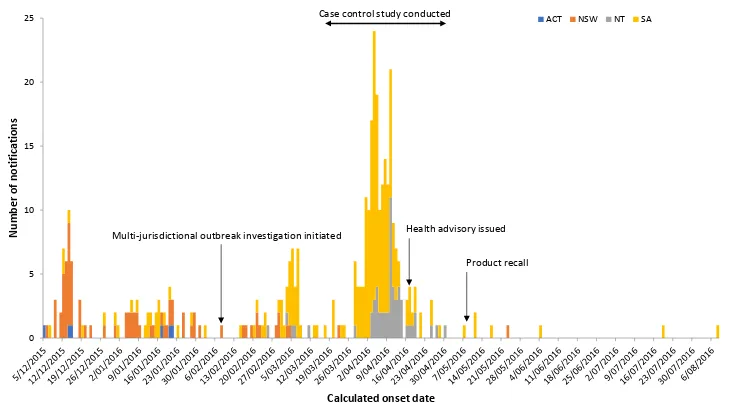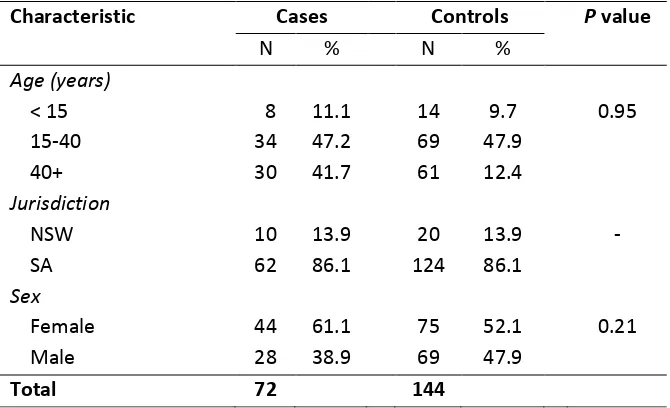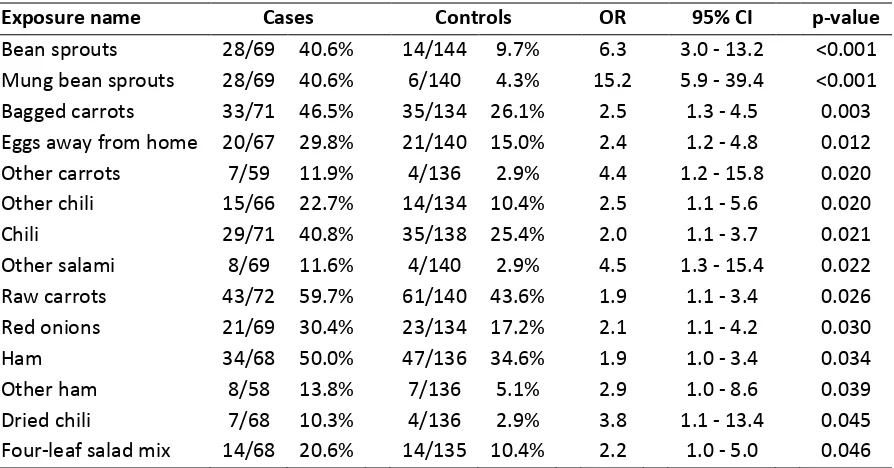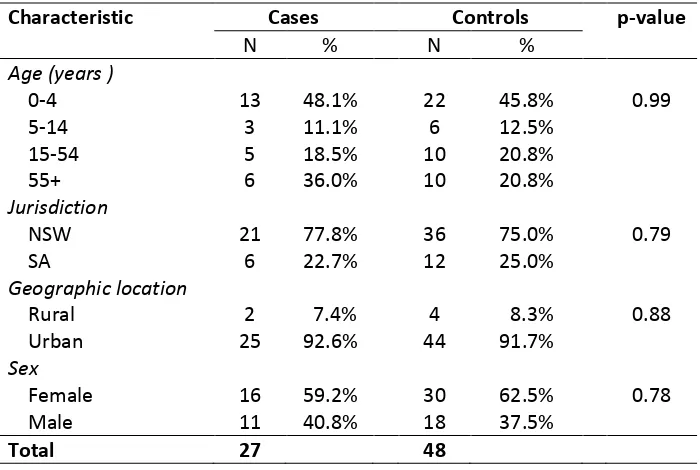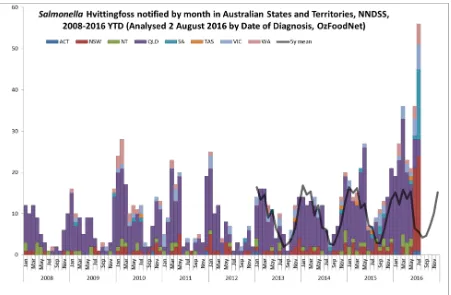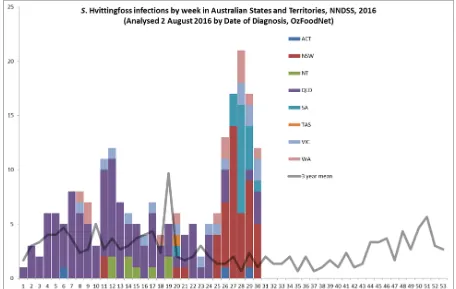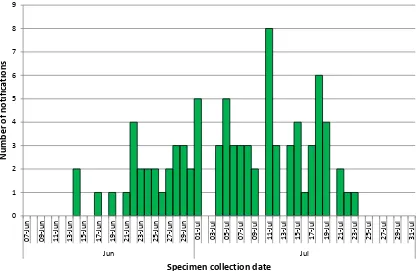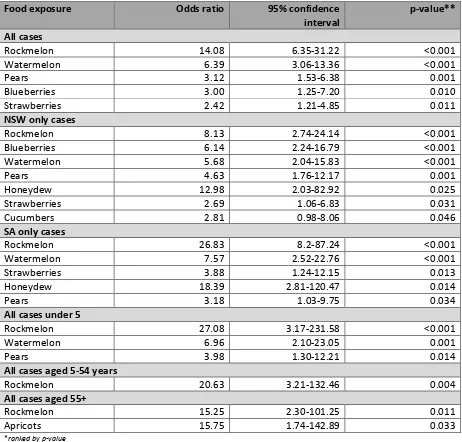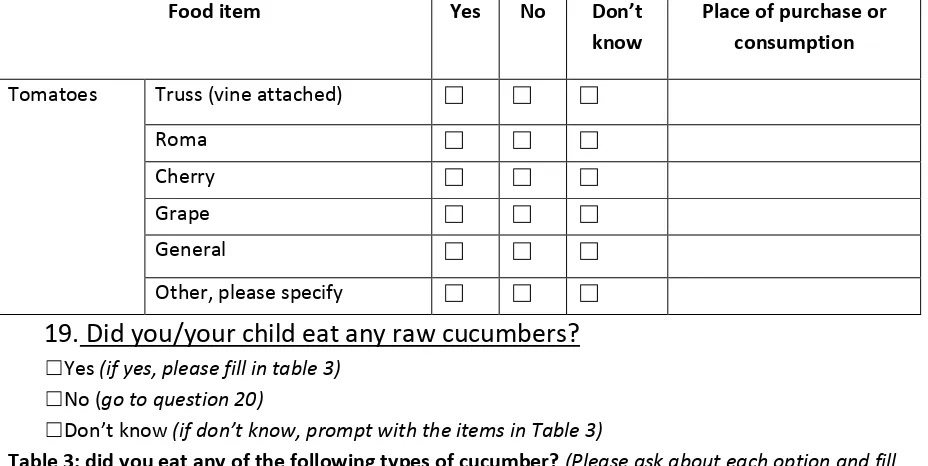Master of Philosophy in
Applied Epidemiology Thesis
Health Protection in New South Wales
A thesis submitted for the degree of Master of Philosophy at the Australian National University
Dr Katherine Todd, MBBS, MPH
2016-2017
NCEPH Supervisor Associate Professor Martyn Kirk
Dr Kerri Viney
Declaration
I hereby declare that this submission is my own work and to the best of my knowledge it contains no materials previously published or written by another person, or substantial proportions of material which have been accepted for the award of any other degree or diploma at ANU or any other educational institution, except where due acknowledgement is made in the thesis. The work was undertaken from February 2016 to November 2017 as part of the degree of Masters of Philosophy in Applied Epidemiology, Australian National University.
Signed: ……….
Acknowledgements
Many thanks to Dr Jeremy McAnulty, my field supervisor at Health Protection NSW, and my
academic supervisor Associate Professor Martyn Kirk for their guidance, generosity and support, for their honest opinions, and for making me feel like I had the skills to do anything. I couldn’t have asked for a better team to guide me through the MAE. Thanks also to Dr Kerri Viney, my academic supervisor in 2016, for her support and assistance.
Thank you also to my colleagues at NSW Health – especially Kirsty Hope for championing me at every turn, Vicky Sheppeard for supporting me in all my endeavours, Neil Franklin and Brett Archer for assistance with all things Enteric and Zoonotic, and everyone else in Communicable Diseases Branch; and the Environmental Health team especially Ben Scalley for always having time to answer another question about lead or epidemiology, and Sheena Kakar, Tara Smith, Carlos Corvalan and Aditya Vyas for many fun Friday meetings. Many thanks also to the team at Parramatta PHU for being so
generous with their time and expertise, especially Shopna Bag, Stephen Corbett and Penny Clark as well as Sophie, Moniek and Jennifer, and in fond memory of Oanh Nguyen who left us far too soon. Thanks also to all the OzFoodNet epidemiologists, especially Megge Miller for always being only a phone call away whenever I had a question about anything foodborne or MAE related; and to Craig Shadbolt of the NSW Food Authority.
Thanks to my cohort of MAE for all the laughs and adventures – especially the “poo patrol” of Julie Collins, Siobhan St Clair (nee Tier) and Rose Wright for advice, laughs, debriefs, encouragement and for always being up for cocktails beside the pool, and my AFPHM buddy Jonathan Malo for your advice about everything from learning contracts to program evaluation, for your encouragement, and for stealing my shoes at every opportunity. Thanks to Meru Sheel for many discussions about careers past and future, to Mica Hartley and Laura Edwards for such a great time at TEPHINET Thailand, and to Sam McEwen, Aly Wright, , Brigitta Osterberger, Kathleen Garton and Linda Turner for many laughs and learnings on course block. Thanks also to MAE 2015 scholars Tanyth de Gooyer and Craig Thompson for their generous help and assistance – the MAE certainly teaches good teachers!
Thanks also to my study buddies Kate, Belinda, Vicky, Sheena and Jonathan for getting me through the AFPHM exam simultaneously with writing the thesis (a terrible idea!) – I couldn’t have done it without your encouragement, and I will miss hearing your voices every day on teleconference! Finally thanks to Mum and Dad for their support and enthusiastic interest in the world of Public Health, to big sister Liz and to Matt for their advice, respite and for allowing cuddles with their dog Teddy whenever required, and finally but certainly not least thanks to little sister, flatmate and co-worker Steph for letting me use her gaming computer to write my thesis, providing ice cream and doughnuts, laughing both at and with me, and for everything else as well.
Abstract
Health protection involves the prevention and control of threats to health from both communicable diseases and the environment. I conducted a variety of projects across the breadth of Health Protection within NSW Health between March 2016 and October 2017 to fulfil the requirements of the Masters of Philosophy in Applied Epidemiology (MAE).
My first placement was within the Enteric and Zoonotic Diseases division of the Communicable Disease Branch. A large outbreak of Salmonella Saintpaul occurred in Australia between December 2015 and June 2016 with a total of 547 confirmed and probable cases notified. When I commenced in March 2016 this outbreak had been underway since December 2015 with no clear vehicle of infection identified. I conducted a case-control study including 72 confirmed cases and 144 controls from SA and NSW which identified that Mung bean sprout consumption was reported by 40.6% (28/69) of cases and 4.3% (6/140) of controls (OR 14.6, 95% CI 5.9-39.4). This outbreak led to a recall of mung bean sprouts from an implicated sprouter in South Australia and public messaging about the safe preparation and consumption of bean sprouts.
In July 2016 six states and territories of Australia were affected by a large outbreak of Salmonella Hvittingfoss with 144 confirmed and suspected cases notified. I led a coordinated multi-jurisdictional investigation to identify the source of infection and control the outbreak, including conducting a case-control study. The epidemiological, microbiological and environmental investigation implicated consumption of rockmelon (OR 7.2, 95%CI 1.87-27.93) from a single producer as a significant risk for infection. The producer initiated a voluntary recall of the product.
My second placement was in the Environmental Health Branch of Health Protection. I completed a review of the epidemiology of notifications in NSW to provide a snapshot of elevated blood lead levels in NSW and to inform an evaluation of the NSW elevated blood lead surveillance system. There were 9,486 notifications of elevated blood lead from 1997–2016, with an average annual notification rate of 6.9 per 100,000. I analysed notification data for by age, sex, geographic area, exposure and occupation and compared notification rates over time and between geographic regions. I identified several limitations with the dataset that made it difficult to analyse notification rates, particularly by risk and exposure history and by blood lead level, and made recommendations to improve the data collection system. I also collected qualitative data about the function of the blood lead surveillance system by conducting face-to-face interviews with key stakeholders throughout NSW. Key areas for improvement in the system included changes to the way data is entered into the surveillance system, greater guidance for public health units on following up
notifications, a review of the information collected on exposure, and guidance regarding liaising with occupational health regulatory agencies to ensure follow-up of occupational notifications.
Contents
Chapter 1 – Introduction ... 1
Chapter 2 – Epidemiological investigation of a large multijurisdictional outbreak of Salmonella Saintpaul: the hazards of stealth ingredients ... 27
Chapter 3 – Multijurisdictional outbreak of Salmonella Hvittingfoss linked to rockmelons, Australia, 2016 ... 89
Chapter 4 – The epidemiology of elevated blood lead levels in New South Wales 1997-2016 ...141
Chapter 5 – An evaluation of the NSW elevated blood lead surveillance system ...183
Chapter 1 – Introduction
During the MAE I travelled the breadth of the state of New South Wales, from Broken Hill to Sydney, Parramatta to Newcastle, as well as across borders to liaise with our interstate colleagues in
Queensland, South Australia and Victoria. I was fortunate to experience a variety of epidemiological projects covering general public health, environmental health, and enteric and zoonotic diseases. My primary placement was within Health Protection NSW. Health protection involves the prevention and control of threats to health from both communicable diseases and the environment. There are two main branches within Health Protection NSW. Communicable Diseases Branch (CDB) has five main divisions which cover immunisation, respiratory and vector-borne disease, blood borne viruses and sexually transmitted infections, enteric and zoonotic diseases, and tuberculosis. The
Environmental Health Branch (EHB) is divided into general environmental health, health policy and risk assessment, Aboriginal environmental health, and the water unit. Each branch has a director who reports to the executive Director of Health Protection.
In addition to the central Health Protection, within NSW there are 15 Local Health Districts (LHD) served by one or more public health units (PHUs), each headed by a PHU Director. These public health units collectively are known as the Public Health network. The PHUs have responsibility for the day-to-day activities of health protection in their district related to communicable diseases, environmental health and immunisation, including following up individual notifications of disease, managing localised outbreaks, and providing community information. The PHU Directors meet with the Directors of Health Protection regularly as members of the Health Protection Leadership Team, including monthly via teleconference and quarterly face-to-face in North Sydney. These meetings are held to discuss current public health issues across the state of NSW. In addition, both branches of Health Protection NSW hold annual workshops on topical issues within their respective fields to which PHU staff from across the state attend, to ensure continuing education and build capacity within the Public Health network.
I conducted a variety of projects between March 2016 and October 2017 to fulfil the requirements of the Masters of Philosophy in Applied Epidemiology (MAE), and participated in the daily life of Health Protection NSW, which included responding to critical incidents, completing education activities and acting as surge staff when needed.
2 ongoing in Australia since December 2015; when I commenced in March 2016 this outbreak
continued with no clear vehicle of infection identified. I conducted a case-control study including cases and controls from SA and NSW which identified an association between mung bean sprout consumption and illness. This outbreak led to a recall of mung bean sprouts from an implicated sprouter in South Australia and public messaging about the safe preparation and consumption of bean sprouts.
In July 2016 six states and territories of Australia were affected by a large outbreak of Salmonella Hvittingfoss with 143 confirmed and suspected cases notified. I coordinated a large
multi-jurisdictional investigation to identify the source of infection and control the outbreak, including conducting a case-control study. The epidemiological, microbiological and environmental
investigation implicated consumption of rockmelon from a single producer as a significant risk for infection, and the producer initiated a voluntary recall of the product.
My second placement was in the Environmental Health Branch of Health Protection. I completed a review of the epidemiology of notifications in NSW to provide a snapshot of elevated blood lead levels in NSW and to inform an evaluation of the NSW elevated blood lead surveillance system. I analysed notification data for by age, sex, geographic area, exposure and occupation and compared notification rates over time and between geographic regions, and identified a number of limitations with the dataset that made it difficult to analyse notification rates, particularly by risk and exposure history and by blood lead level, and made recommendations to improve the data collection system. I also collected qualitative data about the function of the blood lead surveillance system by
conducting face-to-face interviews with key stakeholders throughout NSW. Key areas for improvement in the system included changes to the way data is entered into the surveillance system, greater guidance for public health units on following up notifications, a review of the information collected on exposure, and guidance regarding liaising with occupational health regulatory agencies to ensure follow-up of occupational notifications.
I also contributed to the Health Protection NSW report. This report highlights the major health outcomes and achievements related to Health Protection NSW’s activities on an annual basis. Within this report is a segment titled “Epi Corner” which provides a small vignette on an epidemiological concept, together with some short questions for readers to test their knowledge and understanding of the concept. I authored the 2016 Epi Corner on the topic of case-controls and case-case studies, and the 2017 Epi Corner on confidence intervals and p-values. These are included in Appendix 2. I presented twice at the NSW Health Bug Breakfast seminar series. Bug Breakfast is a series of hour-long breakfast seminars on communicable disease that have been delivered since 1990, and are made available to the entirety of the NSW public health network by attendance in person or via webinar. Typically, a trainee or other employee or NSW Health will identify a key topic, present an overview of the topic, and invite two experts to also deliver presentations around the topic. On the topic of Salmonella in October 2017 I was invited by the convenor to present on the Salmonella Hvittingfoss outbreak I investigated in July-August 2016 (discussed further in Chapter 3). In April 2017, I convened the session on Campylobacter, including giving an introductory presentation and inviting Craig Shadbolt and Martyn Kirk to speak. The flyer and Campylobacter presentation slides are included in Appendix 3.
Whilst working in Communicable Disease Branch, I was the trainee representative on the committee organising the 2016 Communicable Disease workshop. I developed several activities including a quiz on public health topics to engage the attendees and an exercise using chocolates to explore the concept of whole genome sequencing (Appendix 4). I also organised prizes, participated as a
facilitator of a small group, and conducted the final evaluation of the workshop including production of a written document analysing participant responses and outlining what worked well, what didn’t work well and suggestions for improvement for future workshops.
4
Masters of Philosophy (Applied Epidemiology) requirements:
I completed the following requirements for the qualification of Master of Philosophy (Applied Epidemiology):
Field projects
Public health data analysis The epidemiology of elevated blood lead levels in NSW, 1997–2016 (Chapter 4)
Public health surveillance system establishment and evaluation
An evaluation of the NSW elevated blood lead surveillance system (Chapter 5)
Field investigation of a public health problem
Investigation of a multijurisdictional Salmonella Hvittingfoss outbreak (Chapter 3)
Additional requirements
RequirementLiterature review A literature review was completed for each of the field projects listed above
Report to a non-scientific audience
NSW Health “Infection control breaches in cosmetic procedures: Frequently Asked Questions (FAQs)”. Published online 6 July 2016 at
http://www.health.nsw.gov.au/Infectious/alerts/Pages/cosmeti c-procedures.aspx
Publications Draft paper being prepared for publication:
Todd KM, Beazley R, Furlong C, Kenny B, Shadbolt C, Centofanti A, Schobben X, McAnulty J, Kirk M, Sheppeard V, Polkinghorne B, Gregory J, Easton M, Stafford R, Koehler A, Sintchenko V, Howard P, Wang Q, Da Silva AG, Williamson D, and Hope K. A multi-state outbreak of Salmonella Hvittingfoss associated with melons in Australia.
Intended for submission to Epidemiology and Infection Draft paper being prepared for publication:
Todd KM, Scalley B, Kirk M and McAnulty J. The epidemiology of lead poisoning notifications in New South Wales, Australia, 1997-2016.
Intended for submission to Public Health Research and Practice. Oral presentation Todd KM, Miller M, Hope K. A large multi-state outbreak of
Salmonella Saintpaul: the hazards of stealth ingredients. Presented at the NSW Gerry Murphy Prize – Australian Faculty of Public Health Medicine (AFPHM), Sydney, Australia - 19th October 2016
Todd KM, Beazley R, Furlong C, Kenny B, Shadbolt C, Centofanti A, Schobben X, Polkinghorne B, Gregory J, Easton M, Stafford R, Koehler A, Sintchenko V, Howard P, Wang Q, Williamson D, and Hope K. A multi-state outbreak of Salmonella Hvittingfoss associated with melons in Australia, 2016. Paper presented at the 2017 Communicable Disease Control Conference,
Melbourne, Australia, 26-28th June 2017
Todd KM, Scalley B, Kirk M and McAnulty J. The epidemiology of lead poisoning notifications in New South Wales, Australia, 2011-2016. Paper presented at the 9th TEPHINET Global
Scientific Conference, Chiang Mai, Thailand, 7-11th August 2017 Todd KM, Scalley B, Kirk M and McAnulty J. The epidemiology of lead poisoning notifications in New South Wales, Australia, 1997-2016. Paper presented at the 29th Conference of the International Society for Environmental Epidemiology, Sydney, Australia, 24-28th September 2017
6
Teaching
Activity
Teaching first year cohort Tier S, Collins J, Todd K. Outbreaks: What I Wish I Knew. Presented at MAE courseblock March 2017
Bug Breakfast presentations Todd K. Salmonellosis. Presented at the NSW Health Bug Breakfast seminar session, 7 October 2016
Todd K. Campylobacter. Presented at the NSW Health Bug Breakfast, 7 April 2017.
Lesson from the field Todd K. Lesson from the Field: Risk communication. Conducted via teleconference, 20 July 2017
Clinical Associate Lecturer, Integrated Population Medicine Program, University of Sydney Medical School
Tutorial 2 – Social determinants of health (11 March 2016) Tutorial 3 – Costs of care, resource management and low-value care (1 March 2016)
Tutorial 4 – Person-centred management (22 April 2016) Tutorial 5 – Global health (2 June 2017)
Infection control breaches in cosmetic procedures
6 July 2016
Frequently Asked Questions
What has caused this issue?
Following a recent complaint to the Health Care Complaints Commission (HCCC), NSW Health has become aware that Ms Pu Liu, also known as Mabel Liu, has been performing cosmetic procedures from premises situated at 14/239 Great North Road, Five Dock. Ms Liu is not a medical practitioner registered in Australia.
Inspection of the residential unit in Five Dock found evidence of poor infection control.
There is a risk that clients who have had cosmetic procedures performed at this address may have been exposed to blood-borne viruses such as hepatitis B, hepatitis C and HIV. There is also a risk of skin and soft tissue infections and poor cosmetic results.
Injectable drugs not approved for use in Australia were also found on the premises, raising concerns about the safety and effectiveness of these medicines.
The HCCC has issued an order prohibiting Ms Mabel Liu from:
1. Providing any cosmetic surgical and medical procedures, including any cosmetic surgery that involves cutting beneath the skin and any cosmetic medical procedure that involves piercing the skin
2. Possessing any Schedule 4 drugs for cosmetic use including botulinum toxin (Botox) and hyaluronic acid injection preparations (dermal fillers).
NSW Health recommends that clients who have had procedures performed by Ms Liu at this address should seek the advice of a GP and be tested for blood-borne viruses (hepatitis, B, hepatitis C and HIV.)
How was this identified?
A client who had a poor outcome from a cosmetic surgical procedure performed by Ms Liu at the Five Dock premises made a formal complaint to the Health Care Complaints Commission.
What did the investigations show?
The inspection of the premises in Five Dock found evidence that surgical and other procedures were being performed at the premises; drugs for injection that are not registered for use in Australia; and a general environment not suitably fitted out for the performance of surgical procedures.
What infection control problems were identified?
There was evidence of a lack of hygiene, possible re-use of medications and equipment between patients, and a lack of effective cleaning and sterilisation. Sharing items that should be sterile between patients can allow infection to spread from one person to another.
What procedures are classified as “at risk”?
Based on the very poor level of infection control measures found at the premises, there is a concern that any procedure in which the skin was cut or penetrated such as surgery, stitching or injection undertaken at the Five Dock unit could pose a risk of infection. This could be an acute skin or soft tissue bacterial infection, or a blood-borne virus.
Are there any physical symptoms if people have been infected?
There are two main risks of infection: an acute skin or soft tissue bacterial infection caused by unclean hands and instruments (non-sterile technique), and; infection caused by blood-borne viruses.
People experiencing acute skin or soft tissue bacterial infections might experience:
1. Increased pain at the site of the procedure 2. The site may be red, hot, swollen and painful
3. There may be pus or the wound may smell; stitches may come apart 4. Tiredness, sickness or a fever (temperature above 37.5°C)
5. Becoming very unwell (“septic”) and needing antibiotics urgently.
People will experience these symptoms in the first few days after a procedure. If you feel unwell or experience any of the above after having a cosmetic procedure done, you should seek health advice from your GP.
People exposed to a blood-borne virus might experience:
1. No symptoms for months or years afterwards 2. A mild illness when first infected
3. Uncommonly, people present with acute hepatitis when first infected with hepatitis B or hepatitis C, which causes liver problems and may lead to hospitalisation.
Infections with these viruses can be detected by a blood test.
Can you describe the testing process?
Testing for blood borne viruses is straightforward – all that is required is for you to attend your GP and ask to be tested. Your GP can order a blood test to check if you have hepatitis B, hepatitis C or HIV. We suggest you take this fact sheet with you when you visit your GP.
When will results be available?
Results for hepatitis B, hepatitis C and HIV testing are usually available within a few days of testing.
Where will testing take place?
Do patients have to pay to see their doctor and have their blood
test done?
Patients should follow their usual practice when visiting their doctor and get the blood tests through the usual Medicare processes.
What do patients do if they have a positive test result?
You should talk to your doctor about your results.
What does it mean if I have a positive test result?
A positive result means that you have been infected with a blood borne virus sometime in the past. For hepatitis B and C, you may have cleared the virus by yourself, or you may have a long-term (chronic) infection. Your doctor will tell you whether or not your infection is active now. HIV infection is a lifelong infection. There are effective treatments for these infections, so it is
important to know whether you are infected or not, so that you can be assessed and receive treatment if needed.
There are many ways in which people can get infected with HIV and hepatitis B and C viruses. If you have been recently infected with one of these viruses, your doctor should notify the local Public Health Unit and work with the local Public Health Unit to investigate possible sources of your infection.
For more information on infection with blood borne viruses please refer to the Hepatitis B,
Hepatitis C or HIV factsheets.
How many patients are at risk?
Due to the poor record keeping practices at the Five Dock premises, it is not clear how many clients may be at risk.
Are there services like this being provided by other people?
There may be other unregistered practitioners operating in NSW who perform cosmetic procedures and/or surgeries in unregulated, unlicensed premises including homes and hotels. These may also pose a health risk
How can I protect myself?
If you are considering cosmetic surgical and medical procedures you should undertake careful research and make sure the person doing the procedure is qualified to do so. Members of the public can search the Australian Health Practitioner Regulation Agency’s register to check that a health practitioner is registered.
If you have had a procedure with a poor outcome or have concerns about a practitioner or location you can inform the HCCC on 1800 043 159. This phone line operates from 9am to 5pm on weekdays and can provide advice on how to make a complaint. Information about how to make a complaint can also be accessed by following the link on the HCCC’s website.
Further information on how to protect yourself and how to make a complaint can also be accessed by following the link to the public warning made by the HCCC on 30 June 2016.
有關
Mabel LIU
女士所做的外科整容手術程序的問答
收到最近向醫療保健投訴委員會
(HCCC)
的一
份
投訴以後
,
新州衛生廳
獲知
PU LIU
女士
,
又名
Mabel LIU
女士
,
在
14/239 Great North Road, Five Dock
地址做整容
。
劉
女士不是在澳大利亞註冊的醫生
。
檢
查
在
Five Dock
的住所發現證據顯示該住所缺乏防範感染措施
。
那些曾在該地址進行美容手術的客戶可能已經感染血源性病毒例如乙型和丙型肝炎病
毒和艾滋病毒
。
皮膚和軟組織可能也受到感染以及美容效果不佳
。
在該處所也發現澳大利亞不允許使用的注射藥物
,
這些藥物的安全性和有效性令人擔
憂
。
HCCC
發出命令
,
禁止
Mabel LIU
女士
:
a.
提供任何整容手術和醫療程序
,
包括任何涉及切割皮膚整容手術
,
任何涉及
刺入皮膚穿孔的
美容醫療程序
。
b.
擁有任何附表
4
美容用藥
,
包括肉毒桿菌毒素
(
肉毒桿菌
)
和透明質酸注射
製劑
(
真 填
皮
充物
)。
新州衛生廳建議
,
曾在該地址接受劉女士手術程序的客戶應該諮詢家庭醫生並做血液
傳播病毒
(
乙型和丙型肝炎病毒和艾滋病毒
)
的檢測
。
如何發現了這一情況
?
一位在
Five Dock
地址接受
LIU
女士整容手術結果不佳的客戶向醫療保健投訴委員會
提出正式投訴
。
調
查
結果發現什
麼
問題
?
檢
查
Five Dock
處所有證據顯示該處所用於手術和其他醫療程序
;
注射藥物未經註冊未
經允許在澳大利亞使用
;
和整體環境裝修不宜做外科手術
。
發現
哪
些預防感染措施問題
?
有證據顯示衛生較差
、
有可能患者和患者之間重複使用藥物和設備
,
以及缺乏有效的
洗和消毒
什 程序被列
麼
為
“
有危險
”?
因
為
在處所內發現的預防感染措施非常差
,
任何在
Five Dock
處所進行的皮膚切割或
穿孔醫療程序如手術
,
縫合或註射都可能造成感染
。
感染可能會是一種急性皮膚或軟
組織的細菌感染
,
或血源性病毒感染
。
如果被感染是否有任何身體不適症狀
?
感染主要有兩類
:
由於不干淨的手和儀器
(
非無菌技術
)
引起的急性皮膚或軟組織細
菌感染
;
和由血液傳播的病毒引起的感染
。
受急性皮膚或軟組織細菌感染的人可能會感到
:
1.
在手術部位疼痛加劇
2.
該部位可能出現紅
、
熱
、
腫及疼痛
3.
可能出現膿血或傷口異味
;
針口可能會裂開
。
4.
疲勞
、
生病或發燒
(
高於
37.5℃
度
)
5.
變得非常不適
(“
潰瘍
”)
並迫切需要抗生素
。
某些人在手術程序後頭幾天會出現以上症狀
。
如果
你
在做完美容手術後感到不適或出
現上述情況
,
你
應該去看
您
的家庭醫生
。
受到血源性病毒影響的人可能會
:
1.
之後數月或數年無症狀
2.
感染初期會輕微發病
3.
剛感染乙型肝炎或丙型肝炎
,
少數人會得急性肝炎
,
這會導致肝臟出現問
題
,
並可能需要住院治療
。
這些病毒的感染可以通過血液測試來檢測
。
是否能描述一下測試過程
你
?
血液傳播的病毒測試很簡單
–
你
只需諮詢
您
的家庭醫生
,
並提出要求檢測
。
您
的家庭
醫生可以安排驗血
,
檢測
你
是否有乙型肝炎
,
丙型肝炎或艾滋病
。
我們建議
,
當
您
去
看
你
的家庭醫生時帶上這
份
資料
。
去 裡檢測呢
哪
?
血液測試可以通過
你
的家庭醫生安排
,
並且通常可以在當地的病理檢測中心檢測
。
病人看醫生和驗血需要付費
嗎
?
患者去看自己的醫生時應該按照他們的慣例
,
並通過常規的
Medicare
程序做血液檢
查
。
如果檢測結果是陽性的
,
病人該
怎麼
辦
?
應該跟
的醫生討論檢驗結果
你
你
。
如果我的測試結果是陽性
,
這意味著什
麼
?
陽性結果意味著
你
曾經感染血液傳播病毒
。
對於乙型和丙型肝炎
,
你
也許已經自行
清
除了病毒
,
或者
你
也可能受到長
期性的
(
慢性
)
感染
。
你
的醫生將會告訴
你你
受到的
感染是否依然是活性
。
艾滋病毒感染是一種終身感染
。
對這些感染都有有效的治療方
法
.
所以
,
首先要
搞清 你
楚 是否受到感染
.
這樣
你
就可以接受評估和做相應的治療
。
感人艾滋病毒
,
乙型和丙型肝炎病毒的渠道有多種
。
如果
你
最近受到
其中一種這些病毒
的感染
,
你
的醫生
應該通知當地的公共衛生部門
,
並與當地的公共衛生部門一起調
查
感染的可能來源
你
。
有關血液傳播病毒感染的詳細信息
,
請參閱
:
http://www.health.nsw.gov.au/Infectious/factsheets/Pages/default.aspx
有多少病人可能受到影響
?
由於位於
Five Dock
的住所缺乏保存記錄
,
目前 不
尚 清
楚有多少客戶可能受到影響
。
有沒有其他的人也在提供同類服務
?
在新南威爾士州
,
可能有其他未註冊的從業人員
,
在未受監管和無牌照的場所
,
包括住宅
和酒店
,
從事美容程序和
/
或手術
。
這些都可能對健康構成威脅
。
我該如何保護自己
?
如果
你
在考慮做整容手術和醫療程序
,
你
應該做仔細的
研
究
,
並確保操作該程序的人
員符合資格
。
市民可以通過下列網址
,
搜索澳大利亞衛生執業者監管機構的註冊記錄
,
證某個衛生從業者是否登記註冊
如果 做了美容醫療程序而結果不佳
你
,
或對某個從業人員或場所有疑問
,
你
可以聯繫衛
生保健投訴委員會
,
電話
: 1800 043 159.
星期一到星期五
,
上午
9
點到下午
5
點
.
工作人
員可以就有關如何進行投訴提供建議
。
如何進行投訴的信息也可以通過訪問下列
HCCC
網站上的鏈接獲得
:
http://www.hccc.nsw.gov.au
有關如何保護自己
,
如何進行投訴的更多信息
,
也可以
從
2016
年
6
月
30
日
起通過下
面的鏈接獲得
:
public warning made by the HCCC
我可以從那裡獲得更多的信息
?
Epi Corner 1 – September 2016
Case-control studies
Case control studies have traditionally been frequently used to determine exposures in outbreaks. Their benefits include that they can be carried out rapidly, usually do not require as large a sample size as cohort studies, and are generally less expensive. They allow for multiple exposures to be studied, and for a rare event, they are often the only practical way to test a hypothesis.
However, case-control studies have their limitations; one of the major limitations is their potential for bias, particularly recall and selection bias. In cases of an acute illness like gastroenteritis, patients may search for a cause for their illness, and so be more likely to report an exposure (for example, eating takeaway chicken) than controls; this is a form of recall bias.
It can also be difficult to define an appropriate control group, and methods to select controls also have the ability to introduce selection bias. Traditional sources of controls in case-control studies include:
• Population controls – these are people randomly selected from the general population, for example by random-digit dialling by telephone, or knocking on every third door in a
neighbourhood. These control selection methods can be very time-consuming and expensive
• Friend controls – the case is asked to nominate a friend to serve as their control
• Physician nominated controls – this involves asking the patients’ GP to select a similar patient from their records to act as a control
In traditional case-control studies, a significant bias can arise because controls are selected
randomly, whereas cases that are notified to public health authorities have undergone a process of self-selection. This arises because not all people who suffer from a disease will present to their GP for testing, and not all tests recommended by GPs will be carried out. For every case of salmonella reported in surveillance systems in Australia, it is estimated that there could be between 3 and 12 cases occurring in the community who do not present to GPs and/or undertake faecal testing. This process can be affected by factors such as occupation, social status, health seeking behaviours; and these factors can also be related to differences in possible exposures, for example diet.
Therefore, in this population, the notified cases do not represent a truly random sample of cases.
Case-case studies and their advantages
As we have discussed, the difference in exposure histories seen in a traditional case-control studies between cases and controls may not be due to true differences in exposure, but to biases involved in the how cases are selected (via surveillance system notifications) vs. controls (which are randomly selected).
An alternative is the case-case study. Case-case studies draw on pre-existing surveillance systems and use notifications of different diseases, or of different serotypes of the same disease, as proxy controls. An example of the use of case-case studies is in the setting of salmonellosis. In Australia,
Appendix
-
i orner
Salmonella strains are subtyped in the reference laboratory by serotyping, allowing further characterisation of salmonellosis as caused by Salmonella Typhimurium, Salmonella Enteriditis, Salmonella Virchow, etc. This subtyping allows for the identification of outbreaks of less common Salmonella serovars.
The data collected on cases via routine surveillance mechanisms can be used in the place of controls to compare exposure histories between different groups of cases. For example, in an ongoing outbreak of one particular Salmonella strain – e.g. Salmonella Hvittingfoss – information on exposures for these cases, as collected using standard questionnaires, can be compared against exposure data from other recent interviewed cases of Salmonella Typhimurium as controls.
This method is time and cost efficient, as it removes the difficulties of identifying community controls for the outbreak and draws on pre-existing surveillance systems. It also helps eliminate the recall and selection biases associated with traditional case-control studies
Benefits of case-case studies:
1. All cases came through the same selection process, therefore biases that may be introduced by differences in health-seeking behaviours etc. between cases and randomly-selected controls is minimised
2. It reduces differences in recall between cases and controls, as both cases and “controls” in this method have suffered from a recent gastrointestinal disease, and will have had the same consideration given to potential exposures
Disadvantages of case-case studies
1. Problems can arise with validity – in the case-case study, each “control” will have one exposure which differs systematically from that of the cases – the exposure which led to their own infection. For example, if using Salmonella Typhimurium cases as controls, there may be higher rates of consumption of chicken in the control group compared to the case group. The bias whereby all of the cases form the previous outbreak may differ from the general population in some important aspect could be circumvented by mixing cases from several different serotypes in the pool of controls
2. In small populations, it can be difficult to source a large enough group of controls
3. If using historical cases as controls, there is the problem that dietary habits can change over time – therefore “controls” should not be more than a few years old at most
4. There can be seasonal variation in eating habits, particularly around fresh produce and salads, which may lead to systematic differences between cases and control groups if the control group cases occurred at a different time of year.
Questions
We have discussed recall bias and selection bias. What are some other types of biases that can arise in epidemiological studies?
2. Information bias: errors in the collection, analysis and interpretation of data 3. Confounding
Bibliography
Brownson, R. C., & Petitti, D. B. (1998). Applied epidemiology: theory to practice. Oxford University Press on Demand.
Giesecke, Johan (2002). Modern infectious disease epidemiology, 2nd edition. Edward Arnold
(Publisher) Ltd
Hall, G., Yohannes, K., Raupach, J., Becker, N., & Kirk, M. (2008). Estimating Community Incidence of Salmonella, Campylobacter, and Shiga Toxin–producing Escherichia coli Infections, Australia. Emerging Infectious Diseases, 14(10), 1601–1609
Krumkamp, R., Reintjes, R., & Dirksen-Fischer, M. (2008). Case–case study of a Salmonella outbreak: An epidemiologic method to analyse surveillance data. International journal of hygiene and environmental health, 211(1), 163-167
McCarthy, N., & Giesecke, J. (1999). Case-case comparisons to study causation of common infectious diseases. International Journal of Epidemiology, 28(4), 764-768
Epi corner 2 – October 2017
Confidence intervals and p-values
When we get a result from an epidemiological study, the result can be due to three things:
1. Chance (also known as random error)
2. Bias or error 3. Confounding
The impact of chance on the results of a study is usually expressed as p-values and confidence
intervals. The impact of chance on results is mostly determined by the sample size of the study.
P-values
The p-value (or probability value) represents the probability that the association shown in a research study could have occurred by chance alone, if there was no actual relationship between the
exposure and outcome.
The size of the p-value helps you understand the possible impact of chance on the result. A statistically significant p-value is traditionally set at less than or equal to 0.05 – this number means that if you repeated the same study 20 times, the probability that the observed result could occur due to chance alone is 5 out of 100 (or 1 in 20). Similarly, a p value of 0.001 means that the
probability of the result being due to chance is 1 in 1000. The smaller the p-value, the less likely the results are due to chance.
P-values can be very useful because their method of calculation includes a lot of information, including the sample size, the sampling variation, and difference from expectation, all in one convenient number. Many modern statistical software packages such as SPSS or SAS will calculate the p-value automatically for many different types of statistical test. However, the p value can often be misused. The p value is heavily influenced by sample size – the bigger the population the more likely you are to find a significant result of some kind, even if the statistically significant result is clinically meaningless.
Confidence intervals
Confidence intervals provide an indication of the precision of the result obtained from the study. The confidence interval expresses the concept that the result achieved from the study is probably not 100% accurate, and that the real answer lies somewhere within a given range – the confidence interval is the range within which the true answer is likely to lie.
Traditionally confidence intervals of 95% are used. A 95% confidence interval means that if we repeated the same study many times, then we would include the true result in our interval 95% of the time.
Question
An outbreak of Salmonella Dural occurred in a large town. To identify risk factors for infection, the public health unit conducted a case-control study with 13 cases and 25 controls frequency-matched for age and sex. Telephone interviews were conducted using a standardized questionnaire. Raw dragonfruit consumption was the only exposure significantly associated with illness (OR, 26.7; 95% CI, 5.4-101.5; P = .003).
1. What is the confidence interval? 2. What is the p-value?
3. Write a sentence interpreting these two results
4. What do you think of the size of the confidence interval? What could you do to change the size of the confidence interval?
Answer
1. The confidence interval is between 5.4 and 101.5 2. The p-value is 0.003
3. The odds ratio was 26.7. If we repeated the same experiment 100 times, 95% of the time the odds ratio would lie between 5.4 and 101.5. The probability of this result occurring due to chance is 3 in 1000.
4. The confidence interval is very wide (between 5.4 and 101.5). This is because there was a very small sample size of only 13 cases and 25 controls. If we increased the number of cases and controls in our study (increasing the sample size), this would result in a narrower confidence interval (i.e. a more precise estimate)
References
Beatty, M. E., LaPorte, T. N., Phan, Q., Van Duyne, S. V., & Braden, C. (2004). A multistate outbreak of Salmonella enterica serotype Saintpaul infections linked to mango consumption: a recurrent theme. Clinical infectious diseases, 38(9), 1337-1338.
Bonita, R., Beaglehole, R., & Kjellström, T. (2006). Basic epidemiology. World Health Organization
Boslaugh, S. (Ed.). (2007). Encyclopedia of epidemiology. Sage Publications
Elliot, M., Fairweather, I., Olsen, W., & Pampaka, M. (2016). A Dictionary of Social Research Methods. Oxford University Press.
Hoekstra, R., Morey, R. D., Rouder, J. N., & Wagenmakers, E. J. (2014). Robust misinterpretation of confidence intervals. Psychonomic bulletin & review, 21(5), 1157-1164.
Porta, M. (Ed.). (2014). A dictionary of epidemiology. Oxford University Press.
Somerville, M., Kumaran, K., & Anderson, R. (2016). Public health and epidemiology at a glance. John Wiley & Sons.
Introduction to the exercise
There is no wrong answer – this is about understanding some of the basics of trees and what they are showing.
This exercise is about looking at what characteristics are shared. This can be ingredients, preference, brand etc., but whatever participants choose, it should be clear what criteria they are using.
- Let participants know that trees haven’t always been drawn from genetics – they can be drawn from physical traits, behaviour, and fossil record.
- Make sure that all the taxa (chocolates) are at terminal nodes – nothing can be within the tree
- Discuss how the tree would look different if you chose different criteria.
Encourage the table to take photos of completed trees (before eating)
Question:
Create a WGS tree with the following chocolates
Appendix
-
S teaching e ercise for
or sho
Remote Site Participants: Albury Base Hospital WebEx Contact: Tracey Oakman (02) 6080 8916
Bathurst Population Health
WebExContact: Deborah Shaw (02) 6330 5941
Broken Hill Hospital
WebEx Contact: Margie Lesjak (08) 8080 1278
Camperdown
WebEx Contact: Essi Huhtinen (02) 9515 9420
Canberra – Department of Health
WebEx Contact: Leroy Trapani (02) 6289 2732
Coffs Harbour
WebEx Contact: Michele Greenwood (02) 6656 7676
Dubbo - Allan Coates Cancer Centre
WebEx Contact: Therese Channell (02) 6809 8963
Goulburn - Springfield House
WebEx Contact: Lisa Stephenson (02) 4824 1840
Gosford Hospital
WebEx Contact: Kirsty Graham (02) 4320 3382
Gosford PHU
WebEx Contact: Paul Cook (02) 4320 9737
Lismore PH Planning & Performance site WebEx Contact: Colleen Nosworthy (02) 6588 2750
Liverpool - Refugee Health Service
WebEx Contact: Elaine Ochoa (02) 8778 0770
Newcastle Wallsend
WebEx Contact: Julie Kohlhagen (02) 4924 6477
Parramatta – Cumberland Campus WebEx Contact: Shopna Bag (02) 9840 3603
Penrith – Nepean Blue Mountains LHD George Truman (02) 4734 2022
Port Macquarie Community Health Centre WebEx Contact: Colleen Nosworthy (02) 6588 2750
Randwick Hospital
WebEx Contact: Liz Smedley (02) 9382 8309
Tamworth Office - Hunter New England PHU WebEx Contact: Peter Massey (02) 6764 8000
Wagga Community Health
WebEx Contact: Tony Burns (02) 6933 9120
Westmead - Children’s Hospital
WebEx Contact: Robyn Ivey (02) 9845 3566
Bug Breakfast Topic: Salmonellosis
7 October 2016
08.15am – 09:30am AEST
Hosting Venue: NSW Ministry of Health
Level 4, 73 Miller Street, North Sydney - Taronga, Tumbalong & Kurraba Rooms
Click here to
register
In-Person
attendance
Remote sites
click here to
register for
WebEx
SPEAKERS
•Leigh McIndoe, Trainee Public Health Officer, NSW Ministry of Health
•Dr Katherine Todd, Master of Applied Epidemiology (MAE) Scholar, Public Health Medicine Registrar •Marianne Tegel, Policy and Regulatory Manager, Woolworths Food Company
Remote Site Participants: Albury Base Hospital WebEx Contact: Bridget Doyle (02) 6080 8900
Bathurst LHD Hampden Park Road WebEx Contact: Deb Shaw (02) 6330 5880
Broken Hill Hospital
WebEx Contact: Guddu Kaur (08) 8080 1278
Camperdown
WebEx Contact: Essi Huhtinen (02) 9515 9420
Canberra – Department of Health
WebEx Contact: Leroy Trapani (02) 6289 2732
Coffs Harbour
WebEx Contact: Michele Greenwood (02) 6656 7676
Dubbo – Pop House
WebEx Contact: Kerry Gordon (02) 6809 8979
Goulburn - Springfield House
WebEx Contact: Lisa Stephenson (02) 4824 1840
Gosford Hospital
WebEx Contact: Kirsty Graham (02) 4320 3382
Gosford PHU
WebEx Contact: Paul Cook (02) 4320 9737
Hornsby PHU
Webex Contact: Adelaide Nyinawingeri (02) 9477 9057
Grafton
Lismore PH Planning & Performance site WebEx Contact: Colleen Nosworthy (02) 6588 2750
Liverpool - Refugee Health Service
WebEx Contact: Elaine Ochoa (02) 8778 0770
Newcastle Wallsend
WebEx Contact: Julie Kohlhagen (02) 4924 6477
Parramatta – Cumberland Campus WebEx Contact: Shopna Bag (02) 9840 3603
Penrith – Nepean Blue Mountains LHD George Truman (02) 4734 2022
Port Macquarie Community Health Centre WebEx Contact: Colleen Nosworthy (02) 6588 2750
Randwick Hospital
WebEx Contact: Liz Smedley (02) 9382 8309
Tamworth Office - Hunter New England PHU WebEx Contact: Peter Massey (02) 6764 8000
Wagga Community Health
WebEx Contact: Tony Burns (02) 6933 9120
Westmead - Children’s Hospital
WebEx Contact: Robyn Ivey (02) 9845 3566
Wollongong Hospital - SEALS South Pathology WebEx Contact: Diane Lovatt (02) 4221 6700
Wyong Hospital
BUG BREAKFAST
Campylobacter
7 April 2017
08.15am – 09:30am AEST
Hosting Venue: NSW Ministry of Health
Level 4, 73 Miller Street, North Sydney - Taronga, Tumbalong & Kurraba Rooms
Click here to
register
In-Person
attendance
Remote sites
click here to
register for
WebEx
SPEAKERS
Dr Katherine Todd, Master of Applied Epidemiology (MAE) Scholar, Health Protection NSW and Australian National
University
Dr Craig Shadbolt, Food Incident Response & Complaints Manager, NSW Food Authority
Associate Professor Martyn Kirk, National Centre for Epidemiology and Population Health (NCEPH), Australian
Dr Katherine Todd
Master of Applied Epidemiology (MAE) Scholar Health Protection, NSW Health
April 2017
Campylobacter
BackgroundSpiral, “S” or curved, rod shaped bacteria
17 species and 6 subspecies within the genus Campylobacter C. jejeni and C. coli most frequently reported in human disease
Inhabit the intestinal tract of warm-blooded animals Frequently detected in foods derived from these animals
Background Public Health Importance
Public Health Importance
Most common bacterial cause of human gastroenteritis in the world
96 million foodborne illnesses globally each year
Leading foodborne illness in children under five years of age Infections are generally mild, but can be fatal
0 20 40 60 80 100 120 140 160 180 200
ACT NSW NT QLD SA Tas Vic Wa Aust
N o ti fi cati o n r ate p er 100, 000 State/Territory
Notification rates per 100,000 of Campylobacter, Australia, 2014, by state or territory
Clinical features of campylobacteriosis Clinical features of campylobacteriosis
Onset usually occurs 2-5 days after infection Symptoms include:
–diarrhoea (frequently bloody)
–Abdominal cramping and pain
–Fever
Symptoms typically last 3-6 days
Rarely, campylobacter can cause invasive disease
Sources and transmission Sources and transmission
Undercooked meat, especially chicken Unpasteurised milk or drinking water
Eating cooked food which has been cross-contaminated with Campylobacter from raw food
Handling infected animals Person-to-person
Treatment Treatment
Usually a self-limited condition
Diagnosis Diagnosis
Suspect in the setting of severe abdominal pain with diarrhoea
Detected via stool culture or CIDT Speciation and strain typing may be useful epidemiologically
Further typing is usually performed in specialised reference laboratories
Prevention Prevention
Hand washing Cooking
Careful food preparation
–Cook all raw foods, especially meat
–Wash raw vegetables
–Preventing cross-contamination of raw and cooked foods Temperature control
Isolation of unwell children from school or child care Preventing unwell food handlers from working
Outbreaks Notification in NSW
Summary
Campylobacter is an important cause of infectious gastroenteritis
Presentation ranges from mild self-limiting infection (common) to severe disease and long-term sequelae or death (rare) Most commonly contracted from uncooked animal products including poultry, raw milk, and water
Currently notifiable in all states and territories of Australia except NSW
Part I:
Communicable Diseases
Enteric and Zoonotic Diseases
“Everybody always knows something,” said Adam, “even if it’s something they don’t know they know.”
Agatha Christie, “Cat Among the Pigeons”, 1959
“You can't eat tomatoes because they're tainted with deadly salmonella! First there was tainted lettuce. Now, tainted tomatoes. Who would have thought that the healthiest part of a B.L.T. would be the bacon?”
David Letterman, “The Late Show”, 2008
“A bag of Bertie Bott's Every Flavour Beans. ‘You want to be careful with those," Ron warned Harry. "When they say every flavour, they mean every flavour - you know, you get all the ordinary ones like chocolate and peppermint and marmalade, but then you can get spinach and liver and tripe. George reckons he had a booger-flavoured one once."
Ron picked up a green bean, looked at it carefully, and bit into a corner.
"Bleaaargh - see? Sprouts.”
Chapter 2
Epidemiological investigation of a large
multi-state outbreak of
Salmonella
Saintpaul: the hazards of stealth
ingredients
From NewsCorp Australia article: “SA Health says not to eat raw bean sprouts”, April 22nd 2016.
Contents
List of tables ... 29
List of figures ... 29
Abbreviations used in this chapter ... 30
Prologue ... 31
My role ... 31
Lessons learned ... 32
Public health implications ... 33
Abstract ... 34
Introduction ... 35
Methods ... 36
Hypothesis generation ... 36
Case-control study ... 37
Case definition ... 37
Recruitment of cases and controls ... 38
Statistical analysis ... 38
Ethics ... 39
Results ... 39
Hypothesis generation ... 39
Case-control study ... 41
Univariate analysis ... 41
Multivariate regression ... 42
Stratified analysis ... 42
Discussion... 43
Study limitations ... 46
Conclusion ... 47
References ... 47
List of tables
Table 1 – Characteristics of cases and controls recruited into the Salmonella Saintpaul study,
Australia, 10 March – 24 May 2016 ... 41 Table 2 – Food items with elevated odds of exposure among cases of Salmonella Saintpaul infection: case-control study, Australia, 10 March- 24 May 2016 ... 42 Table 3 – Stratified analysis of selected food items consumed by cases and controls ... 43 Table 4 – Association between all food items included in the questionnaire and Salmonella Saintpaul infection: case-control study, Australia 24 March – 10 May 2016 ... 51
List of figures
Abbreviations used in this chapter
ACT Australian Capital Territory
ANU Australian National University
CDB Communicable Disease Branch
CDC Centers for Disease Control and Prevention
CI Confidence Interval
GP General Practitioner
HGQ Hypothesis-Generating Questionnaire
ICPMR Institute for Clinical Microbiology and Medical Research
LGA Local Government Area
MAE Master of Applied Epidemiology
MDU Microbiological Diagnostic Unit
NCEPH National Centre for Epidemiology and Population Health
NSW New South Wales
NSWFA New South Wales Food Authority
NT Northern Territory
OR Odds Ratio
SA South Australia
STM Salmonella Typhimurium
Prologue
My role
My first eight months of the MAE were spent within the Enteric and Zoonotic Diseases division of the
Communicable Disease Branch, Health Protection NSW. When I commenced in March 2016 the
outbreak described in this chapter had been ongoing since December 2015, with no signs of abating
and no clear source identified. NSW had the most cases at the outset of the outbreak, and was thus
leading the outbreak response.
The NSW, SA and ACT OzFoodNet epidemiologists collaborated with public health unit staff and
public health officers within their jurisdictions to interview cases of Salmonella Saintpaul using the
7-day National Salmonella Hypothesis-Generating Questionnaire (HGQ). Information on food purchase
locations ascertained on these interviews were passed on to regulatory agencies in NSW and SA who
conducted traceback, sampling of fresh produce, and liaison with industry about fresh produce
supply patterns. Laboratory staff at the Institute for Clinical Microbiology and Medical Research
(ICPMR) in NSW and the Microbiological Diagnostic Unit (MDU) in Victoria conducted whole genome
sequencing (WGS) of case isolates to identify the extent of the outbreak and confirm which
jurisdictions were affected. In addition, the epidemiologists from SA, NSW and ACT developed a
case-control study protocol to attempt to identify the food vehicle involved in the outbreak via an
analytical study.
During my first week, the case-control study protocol was finalised and I was appointed to
co-ordinate the NSW arm of the study with the assistance of Kirsty and Megge Miller, the SA
OzFoodNet Epidemiologist. As the outbreak gained momentum in SA and simultaneously waned in
NSW, my role changed to include responsibility for data entry and analysis for both states, as
resources in SA were significantly stretched by the extremely large number of cases occurring. At
this point I understood the important role of the MAE in providing a surge staff in the case of acute
public health emergencies.
My role included participating in teleconferences and providing input into the final design of the
questionnaire and protocol for the case-control study. I
was responsible for selecting and allocating cases and controls for interview in NSW, which included
frequency matching by age group and local government area (LGA). I designed and built an Epi-infoTM
database based on the questionnaire, and used this to enter and analyse the data. I was responsible
for conducting daily data analyses at the height of the outbreak pril 2016 . On a typical day, I
and conduct an analysis of the data to prepare and disseminate a report to SA by 4pm; this was done
to enable urgent public health action to be taken on the strength of association that was emerging
between bean sprouts and infection. I was custodian of all NSW data relating to the outbreak,
including maintaining the line list, and provided updates on case numbers for situation reports.
I provided input into the final outbreak report and presented on the outbreak for my public health
physician colleagues at the Australian Faculty of Public Health Medicine (AFPHM) presentation night
in Sydney in October 2016, and at the National Centre for Epidemiology & Population Health
(NCEPH) ANU seminar series as a field report in Canberra in March 2017. I also presented a report on
this outbreak to Infectious Disease medical registrars at a continuing education evening in Sydney in
November 2017. I provided input into the abstract and presentation that Megge Miller presented at
the CDC conference in June 2017, and I will be a co-author on a paper currently being written about
this outbreak.
In this chapter, I report the findings of the case-control study that the investigation team conducted
during the outbreak to identify the likely vehicle of infection, and place this in the context of the
overall epidemiology of the outbreak. Whilst not the focus of this report, I acknowledge all the hard
work that went into the environmental and laboratory investigations during this outbreak, which
were essential in identifying the source of the outbreak and implementing control measures. The
public health actions arising from the investigation of this outbreak are illustrated in the media
reports in Appendix 5.
Lessons learned
This was my first experience of working in a multidisciplinary outbreak team that was dispersed
across multiple geographic locations. I gained an appreciation of the value of large teams (including
access to expertise and human resources from other states, as well as the professional satisfaction in
collaborating effectively), as well as the challenges involved in coordinating a multijurisdictional and
multidisciplinary response. Coordinating activities included managing competing priorities, resource
limitations, the difficulties of communication in large teleconferences, over the phone and by email
and even the simple challenge of coordinating a teleconference across different time zones.
As my first project, I also experienced the challenges of learning and doing simultaneously—time
pressures were so intense that I often had little time to ask or learn how to do new ways of doing
things. As an example, I was initially calculating 2x2 tables one by one for each food exposure
However, I found this process an excellent learning tool because I gained an understanding of the
fundamentals very quickly, and then subsequently appreciated shortcuts when I did discover them.
I also learned about different analytical study designs in case-control studies and the different biases
that can arise through the way cases are selected, how questions are asked, and how controls are
selected. Based on this experience I wrote a segment for “Epi Corner” in the NSW Health Protection
newsletter, included in Appendix 2 in Chapter 1.
Public health implications
This was one of the largest Salmonella common-source outbreaks recorded in Australia. More than
500 people tested positive for S. Saintpaul and it is likely that hundreds more became ill but did not
present for testing. Cases occurred across four states and territories of Australia and were implicated
in several point-source outbreaks in the Northern Territory as well as the wider outbreak.
This outbreak reinforced the potential for contamination of bean sprouts with Salmonella and other
enteric bacteria. Sprouts are a known high-risk food that has been associated with multiple large and
serious outbreaks over recent years, frequently occurring across large geographical areas and often
very challenging to investigate. Sprouts are often described as a “stealth foods”, which are
garnish-type foods that are often poorly identified and recalled by case patients as something they have
eaten. The “stealth” nature of sprouts was reflected in the overall low frequency of recalled sprout
consumption identified in this outbreak (41% among case-control study participants and 30%
overall) reflected findings of other sprout-associated outbreaks both in Australia and
internationally1-11
Although not discussed further in this chapter, the environmental investigation of this outbreak
combined with the epidemiological and microbiological investigation led to the recall of bean sprouts
from an implicated sprout producer in South Australia, as well as the closing down of the sprouting
facility for a period whilst it was improved to meet regulatory standards. The sprouter in South
Australia was unable to be linked with the NSW cases based on supply patterns and it was
hypothesised that contaminated seeds supplied to both states rather than the sprouted beans
themselves were the cause of the outbreak, although this was unable to be proved. Routine
